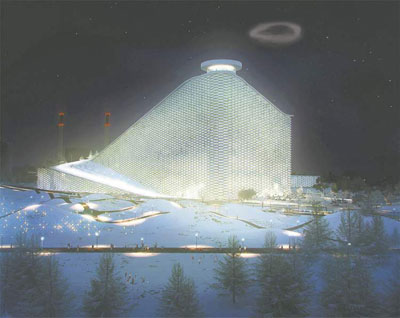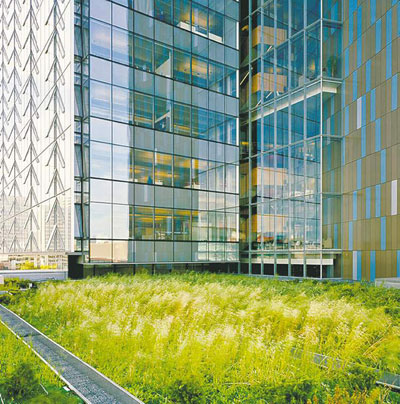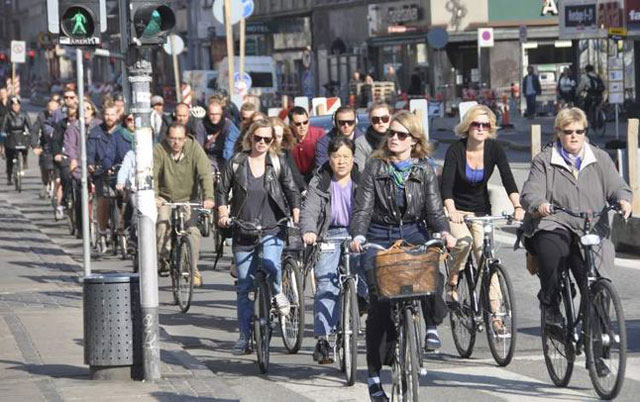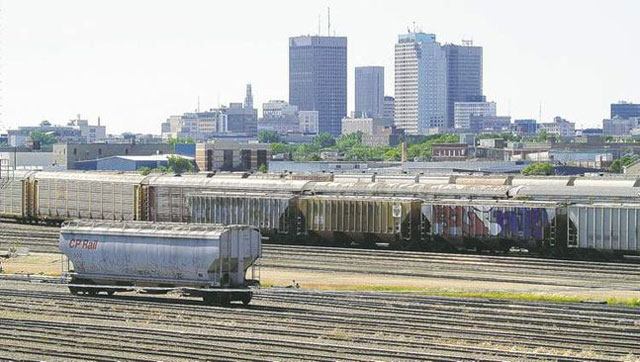What's rotten in Denmark? - Responsibility is fun at cool Copenhagen waste plant
- Details
 Winnipeg is a garbage city.
Winnipeg is a garbage city.
We send more of it to the landfill than any other municipality in Canada, generating 750,000 tonnes of waste each year. This is equal to the weight of nearly 200,000 full grown African elephants, representing more than 1,000 kilograms from each citizen. Even with a blue box in every home, we divert only 17 per cent of our waste from the landfill, the lowest recycling rate in the country and one-third of what cities like Vancouver and Toronto accomplish. That's a lot of elephants.
The most recent topic for discussion in Winnipeg's coffee shops and hockey rinks has been the city's less-than-seamless transition to an automated garbage and recycling collection system.
Putting a little green up above - Rooftop vegetation offers many benefits
- Details
 Do you ever wake up in the morning, turn on the weather channel and notice the temperatures shown at The Forks are often several degrees warmer than those at the airport?
Do you ever wake up in the morning, turn on the weather channel and notice the temperatures shown at The Forks are often several degrees warmer than those at the airport?
You wouldn't think an area's climate would change over six kilometres, but it turns out that annually, the average overnight low at The Forks is -0.7 C while at the airport it is almost three degrees colder at -3.4 C. On sunny summer days, the temperature variation between the downtown and the outskirts of the city can reach six or seven degrees Celsius.
The answer to this puzzle is something called the 'urban heat island effect.' As the name suggests, cities are literally islands of heat. A Google Earth view of downtown shows a landscape of black roofs, asphalt streets and concrete sidewalks. These impervious materials absorb and store the sun's energy, releasing it back into the air as heat. Natural landscapes of soil and vegetation trap moisture and use the sun's energy for evaporation, releasing water vapour that cools the air.
Copenhagen shows bicycles can improve cities and their citizens
- Details

2Home to inspiring modern architecture, set within a dense and vibrant urban context, the most significant impression any visitor has of the Scandinavian capital is an overwhelming presence of bicycles.
In Copenhagen, 37 per cent of the population ride their bikes to work every day. With a vast, integrated system of separated lanes and dedicated lights, rush-hour traffic can often be heavier for cyclists than motorists. The system is so safe only 15 per cent of Danes choose to wear a helmet.
During a recent architectural pilgrimage to the Nordic city, I was lucky enough to visit prominent Danish architect and urban planner Jan Gehl. Having written several influential books on the design of livable cities, he has been instrumental in establishing Copenhagen's bike culture. In our discussion, Gehl lamented the lack of cycling infrastructure in most Canadian cities and cited the significant social and economic benefits it can have. He referred to a study commissioned by the mayor of Copenhagen indicating that when taking all factors into account, every kilometre ridden on a bike saves Danish society 25 cents and every kilometre travelled by car costs them 16 cents.
WAG the arts scene - Architects of new building face challenge
- Details
 In 1912, Winnipeg peaked. The cosmopolitan and bustling young city of 170,000 people was riding a wave of affluence and growth that was without rival in North America. That year, 5,328 buildings were constructed, a boom of prosperity that continues to define the physical character of our city a century later. With a population that had tripled in the previous decade, what had become the third largest city in Canada was the undisputed king of the Prairies.
In 1912, Winnipeg peaked. The cosmopolitan and bustling young city of 170,000 people was riding a wave of affluence and growth that was without rival in North America. That year, 5,328 buildings were constructed, a boom of prosperity that continues to define the physical character of our city a century later. With a population that had tripled in the previous decade, what had become the third largest city in Canada was the undisputed king of the Prairies.
As office towers pushed skyward along Main Street and new residential districts grew away from the rivers, Winnipeg's optimistic young population looked to create a quality of life that would match the older centres of the east. In an effort to construct a "civilized" new metropolis, they would build grand cultural institutions befitting a city whose destiny was thought to be the stature of a Canadian Chicago. Theatres like the Capitol, Metropolitan, Walker and Pantages would rise in the downtown and a group of prominent businessmen would contribute $200 each to rent space in the new Industrial Bureau Building, providing a home for the Winnipeg Museum of Fine Arts, Canada's first civic art gallery.
Rail yard redevelopment would bring density, investment and revenue
- Details

First we need to fix the roads, replace the sewers, fill the potholes. Our property taxes are too high already. We can't afford it. It would cost too much. There are bigger priorities for Winnipeg.
Sentiments like these have generally followed recent public discussion over the potential relocation and redevelopment of the Canadian Pacific Railway yards northwest of the downtown. Instigated by a request to government (by the Social Planning Council of Winnipeg) for a feasibility study, the public debate has met with significant skepticism over the value of what seems to be an unachievable goal, considering the apparent costs and current economic pressures on local government.
It appears to be linear thinking to conclude we cannot afford such a grand dream. If we don't have the money, how can we spend it?


